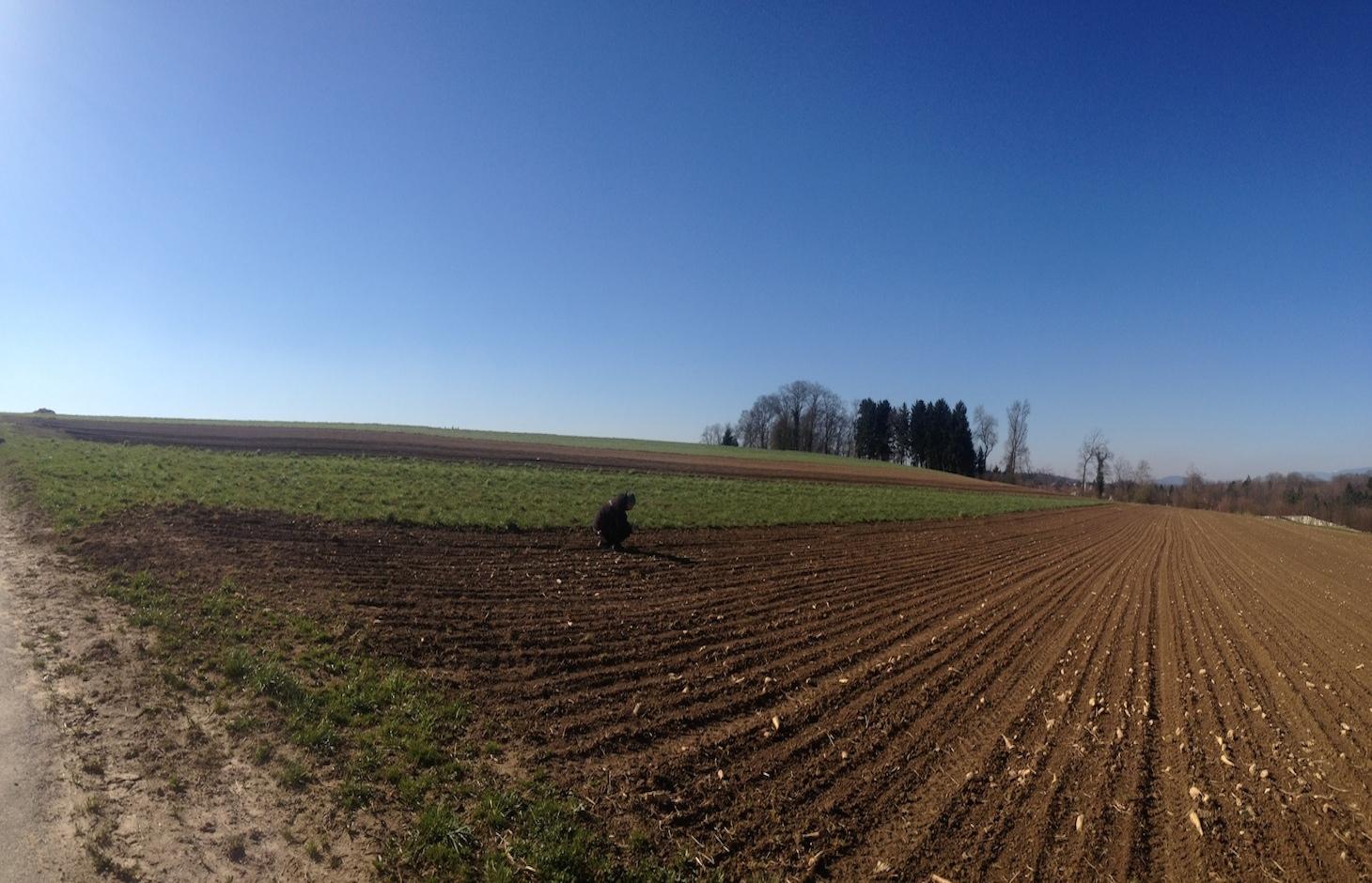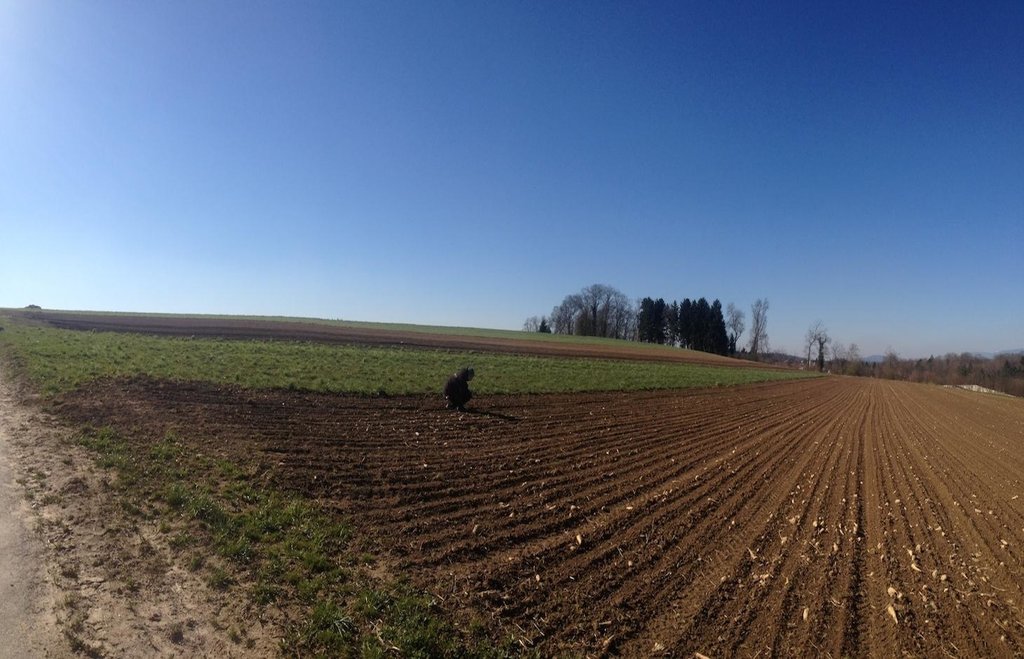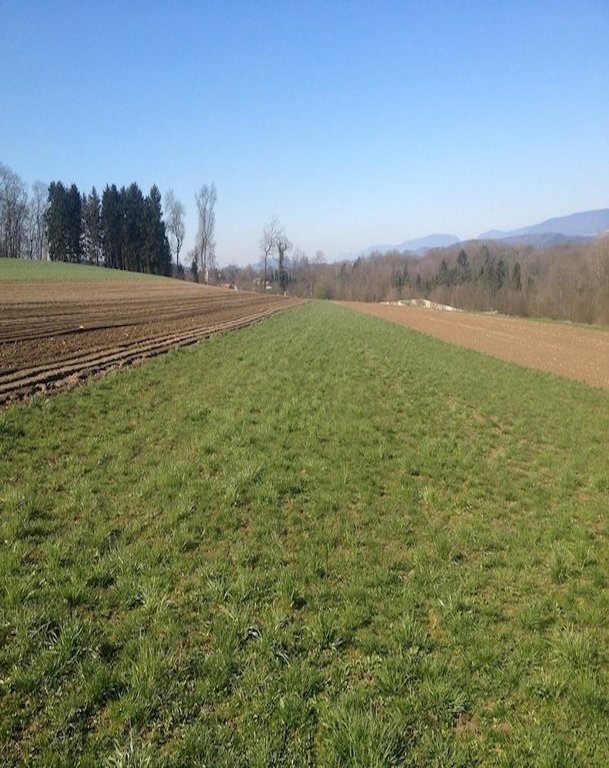Slope subdivision through a field seam [瑞士]
- 创建:
- 更新:
- 编制者: Joana Eichenberger
- 编辑者: –
- 审查者: Fabian Ottiger, Alexandra Gavilano
Hangunterteilung durch Ackersaum
technologies_1670 - 瑞士
查看章节
全部展开 全部收起1. 一般信息
1.2 参与该技术评估和文件编制的资源人员和机构的联系方式
有助于对技术进行记录/评估的项目名称(如相关)
Preventing and Remediating degradation of soils in Europe through Land Care (EU-RECARE )有助于对技术进行记录/评估的机构名称(如相关)
CDE Centre for Development and Environment (CDE Centre for Development and Environment) - 瑞士1.3 关于使用通过WOCAT记录的数据的条件
编制者和关键资源人员接受有关使用通过WOCAT记录数据的条件。:
是
2. SLM技术的说明
2.1 技术简介
技术定义:
A field at risk for erosion by water is divided so that a grass strip prevents soil loss and further damage to the field and the streets during a heavy rainfall.
2.2 技术的详细说明
说明:
The technology applied is an individual idea of a land user whose one field provides many problems whenever there is a heavy rainfall event. Because of the slope and the cultivation it is mostly at risk during summer when there are tempests. To minimize the risk of soil and crop loss the land user decided to leave a part of the filed unemployed and planted a seam of grass and flowers to stabilize the soil. Whenever there is a rainfall event, the grass strip stops the flow of water and eroded top-soil and speed is reduced. Consequently, erosion is highly minimized and the damage to the field, crops and the street underneath stays small.
Purpose of the Technology: The aim of the technology is to prevent erosion and soil loss, especially from heavy rainfall events during summer. Crop loss is also a consequence, so the land user loses not only top-soil and organic material but also crops and in the end money. The reduction of this high risk is the reason for the implementation of a grass strip on this problematic field.
Establishment / maintenance activities and inputs: In the beginning seeds and a seeding machine were required. There is a specially designed mixture for field seams in Switzerland which the land user has to apply. After the first growing period the land user has to cut the grass with a special mowing machine. During the next two years the grass has to be cut every month. This is called the cleanup-cut. After the first two years the grass only needs to be cut twice a year. The grass must be led away.
Natural / human environment: The most important conditions for this technology are a moderate slope on a field which is endangered by erosion through rainfall. The technology can stop and slow down the flow of water over the field to a neighbor field or onto the street and therefore minimize the risk and costs of soil loss and its consequences.
2.3 技术照片
2.5 已应用该技术的、本评估所涵盖的国家/地区/地点
国家:
瑞士
区域/州/省:
Bern
有关地点的进一步说明:
Aarberg
注释:
Comments:
Total area covered by the SLM Technology is 0.0022 km2.
The total SLM Technology area is 22 are
2.6 实施日期
如果不知道确切的年份,请说明大概的日期:
- 不到10年前(最近)
2.7 技术介绍
详细说明该技术是如何引入的:
- 通过土地使用者的创新
注释(项目类型等):
The seam was first seeded in spring 2014 by the land user. He had no help with the development and was the first of his family to change something on the endangered field after a heavy rainfall which took away his top-soil and accumulated on the street underneath the field.
3. SLM技术的分类
3.1 该技术的主要目的
- 减少、预防、恢复土地退化
3.2 应用该技术的当前土地利用类型

农田
- 一年一作
- Main crops (cash and food crops): Other crops: Arable farming and vegetable gardening
每年的生长季节数:
- 1
具体说明:
Longest growing period in days: 200Longest growing period from month to month: April to September or October
注释:
Major land use problems (compiler’s opinion): Run-off during rainfall causes often much soil erosion because of the many slopes in this area. As a consequence of erosion there is soil loss and within this also loss of fertility of the soil.
Major land use problems (land users’ perception): The intensification of agricultural fields is the main problem for the land user. Through a intensely use of the soils the risk for erosion increases. However, one must always also do as much as possible for protecting endangered fields of part of it. This is the solution.
3.4 供水
该技术所应用土地的供水:
- 混合雨水灌溉
注释:
Water supply: rainfed, mixed rainfed - irrigated, full irrigation
3.5 该技术所属的SLM组
- 横坡措施
3.6 包含该技术的可持续土地管理措施

植物措施
- V2:草和多年生草本植物
注释:
Main measures: vegetative measures
Type of vegetative measures: aligned: -linear
3.7 该技术强调的主要土地退化类型

土壤水蚀
- Wt:表土流失/地表侵蚀
- Wm:块体运动/滑坡
- Wo:场外劣化效应
注释:
Main type of degradation addressed: Wt: loss of topsoil / surface erosion, Wo: offsite degradation effects
Secondary types of degradation addressed: Wm: mass movements / landslides
Main causes of degradation: soil management (machines and moment of tillage are highly important regarding compaction of soil), crop management (annual, perennial, tree/shrub) (Crop rotation must be adapted to the situation and problems, sometimes also short to the weather), Heavy / extreme rainfall (intensity/amounts) (Heavy rainfalls were the trigger for the first soil loss and erosion)
Secondary causes of degradation: other human induced causes (specify) (Heavy machines lead to compaction of soils), change in temperature (It was observed that there are longer hot weather conditions), change of seasonal rainfall (It was observed that there are longer wet weather conditions), governance / institutional (Politics and agrarian policy lead to an intensification of land use)
3.8 防止、减少或恢复土地退化
具体数量名该技术与土地退化有关的目标:
- 防止土地退化
- 减少土地退化
注释:
Main goals: prevention of land degradation
Secondary goals: mitigation / reduction of land degradation
4. 技术规范、实施活动、投入和成本
4.1 该技术的技术图纸
技术规范(与技术图纸相关):
Technical knowledge required for field staff / advisors: moderate (They need to know when to cut the grass and how low the grass needs to be cut. There is a certain size the grass needs to have during the first 2 years.)
Technical knowledge required for land users: moderate (He needs to know everything about the implementation from how to seed and cut the grass until how often the grass needs to be cut. This knowledge has to be given to his field staff.)
Technical knowledge required for apprentice: moderate (The land user needs to show his apprentice how everything works: the machines, the seeding, the cutting and the transporting of the cut grass.)
Main technical functions: control of dispersed runoff: impede / retard, control of concentrated runoff: impede / retard
Secondary technical functions: reduction of slope length, improvement of surface structure (crusting, sealing), improvement of topsoil structure (compaction), stabilisation of soil (eg by tree roots against land slides), increase in organic matter, increase of infiltration
Aligned: -graded strips
Vegetative material: C : perennial crops
Aligned: -linear
Vegetative material: G : grass
Number of plants per (ha): 44 kg
Grass species: Mixture "seam on agricultural crop land" with grass and different flower species, seeded
4.2 有关投入和成本计算的一般信息
其它/国家货币(具体说明):
Swiss Franc
如相关,注明美元与当地货币的汇率(例如1美元=79.9巴西雷亚尔):1美元=:
1.0
4.3 技术建立活动
| 活动 | 时间(季度) | |
|---|---|---|
| 1. | Seeding mixture conventionally with seeding machine | May |
| 2. | First cutting after 2 months because grass grows faster than flowers which need light | July/August |
| 3. | Cutting once a month for growing of flowers | during growing period |
4.4 技术建立所需要的费用和投入
| 对投入进行具体说明 | 单位 | 数量 | 单位成本 | 每项投入的总成本 | 土地使用者承担的成本% | |
|---|---|---|---|---|---|---|
| 劳动力 | Labour | ha | 1.0 | 1500.0 | 1500.0 | 100.0 |
| 设备 | machine use | ha | 1.0 | 750.0 | 750.0 | 100.0 |
| 设备 | tools | ha | 1.0 | 500.0 | 500.0 | 100.0 |
| 植物材料 | Seeds | ha | 1.0 | 250.0 | 250.0 | 100.0 |
| 技术建立所需总成本 | 3000.0 | |||||
| 技术建立总成本,美元 | 3000.0 | |||||
4.5 维护/经常性活动
| 活动 | 时间/频率 | |
|---|---|---|
| 1. | Cutting half of grass in August | August after first 2 years of establishment |
| 2. | Cutting other half of grass in September | September |
| 3. | Sell the cut grass as fodder or hay to another land user |
4.6 维护/经常性活动所需要的费用和投入(每年)
| 对投入进行具体说明 | 单位 | 数量 | 单位成本 | 每项投入的总成本 | 土地使用者承担的成本% | |
|---|---|---|---|---|---|---|
| 劳动力 | Labour | ha | 1.0 | 750.0 | 750.0 | 100.0 |
| 设备 | Machine use | ha | 1.0 | 400.0 | 400.0 | 100.0 |
| 设备 | Tools | ha | 1.0 | 300.0 | 300.0 | 100.0 |
| 技术维护所需总成本 | 1450.0 | |||||
| 技术维护总成本,美元 | 1450.0 | |||||
注释:
The costs were calculated for the field of 0.22 ha where the land user has now a grass strip in order to prevent run-off and erosion.
4.7 影响成本的最重要因素
描述影响成本的最决定性因素:
The most determinate factor affecting the costs are the labour and the seeds at the beginning. After the implementation of the seam on this agricultural field the costs are remarkably smaller. Furthermore, the land user gets a small amount of subsidies after the implementation of a seam on agricultural fields. But this amount is not that high that it would be profitable to change from rotation farming to agricultural seams.
5. 自然和人文环境
5.1 气候
年降雨量
- < 250毫米
- 251-500毫米
- 501-750毫米
- 751-1,000毫米
- 1,001-1,500毫米
- 1,501-2,000毫米
- 2,001-3,000毫米
- 3,001-4,000毫米
- > 4,000毫米
有关降雨的规范/注释:
1035-1150 mm, winter rains
农业气候带
- 半湿润
- 半干旱
Thermal climate class: temperate
5.2 地形
平均坡度:
- 水平(0-2%)
- 缓降(3-5%)
- 平缓(6-10%)
- 滚坡(11-15%)
- 崎岖(16-30%)
- 陡峭(31-60%)
- 非常陡峭(>60%)
地形:
- 高原/平原
- 山脊
- 山坡
- 山地斜坡
- 麓坡
- 谷底
垂直分布带:
- 0-100 m a.s.l.
- 101-500 m a.s.l.
- 501-1,000 m a.s.l.
- 1,001-1,500 m a.s.l.
- 1,501-2,000 m a.s.l.
- 2,001-2,500 m a.s.l.
- 2,501-3,000 m a.s.l.
- 3,001-4,000 m a.s.l.
- > 4,000 m a.s.l.
说明该技术是否专门应用于:
- 凹陷情况
关于地形的注释和进一步规范:
Slopes on average: The average slope in the area treated is moderate (6-10%) however the problematic field is situated in a rolling slope (8-16%) there run-off can gain more and more speed during a heavy rainfall event.
5.3 土壤
平均土层深度:
- 非常浅(0-20厘米)
- 浅(21-50厘米)
- 中等深度(51-80厘米)
- 深(81-120厘米)
- 非常深(> 120厘米)
土壤质地(表土):
- 中粒(壤土、粉土)
表土有机质:
- 中(1-3%)
如有可能,附上完整的土壤描述或具体说明可用的信息,例如土壤类型、土壤酸碱度、阳离子交换能力、氮、盐度等。:
Soil texture is medium (loamy/silty) (Soil texture in this area is mostly sandy loam)
Soil fertility is high
Soil drainage/infiltration is medium
Soil water storage capacity is medium
5.4 水资源可用性和质量
地下水位表:
5-50米
地表水的可用性:
好
水质(未处理):
良好饮用水
5.5 生物多样性
物种多样性:
- 中等
5.6 应用该技术的土地使用者的特征
生产系统的市场定位:
- 商业/市场
非农收入:
- 收入的10-50%
相对财富水平:
- 平均水平
个人或集体:
- 个人/家庭
机械化水平:
- 手工作业
- 机械化/电动
性别:
- 男人
说明土地使用者的其他有关特征:
Land users applying the Technology are mainly common / average land users
Difference in the involvement of women and men: In swiss agriculture land users are mainly men. Women or their wives play also an important role especially in case of decision-making, investment and family.
Population density: 100-200 persons/km2
Annual population growth: 1% - 2%
Level of mechanization is mechanised and manual labour (weeding in biological agriculture must be made manual)
5.7 应用该技术的土地使用者使用的平均土地面积
- < 0.5 公顷
- 0.5-1 公顷
- 1-2 公顷
- 2-5公顷
- 5-15公顷
- 15-50公顷
- 50-100公顷
- 100-500公顷
- 500-1,000公顷
- 1,000-10,000公顷
- > 10,000公顷
这被认为是小规模、中规模还是大规模的(参照当地实际情况)?:
- 中等规模的
5.8 土地所有权、土地使用权和水使用权
土地所有权:
- 个人,有命名
土地使用权:
- 社区(有组织)
- 个人
- government
用水权:
- 社区(有组织)
- government
5.9 进入服务和基础设施的通道
健康:
- 贫瘠
- 适度的
- 好
教育:
- 贫瘠
- 适度的
- 好
技术援助:
- 贫瘠
- 适度的
- 好
就业(例如非农):
- 贫瘠
- 适度的
- 好
市场:
- 贫瘠
- 适度的
- 好
能源:
- 贫瘠
- 适度的
- 好
道路和交通:
- 贫瘠
- 适度的
- 好
饮用水和卫生设施:
- 贫瘠
- 适度的
- 好
金融服务:
- 贫瘠
- 适度的
- 好
6. 影响和结论性说明
6.1 该技术的现场影响
社会经济效应
生产
作物生产
注释/具体说明:
More production on the area that remains cultivated.
生产故障风险
生产区域
收入和成本
农业投入费用
农业收入
社会文化影响
SLM/土地退化知识
冲突缓解
Improved livelihoods and human well-being
生态影响
水循环/径流
地表径流
土壤
土壤水分
土壤覆盖层
土壤流失
土壤结壳/密封
土壤压实
生物多样性:植被、动物
栖息地多样性
其它生态影响
Hazard towards adverse events
6.2 该技术的场外影响已经显现
下游洪水
下游淤积
地下水/河流污染
对邻近农田的破坏
对公共/私人基础设施的破坏
6.3 技术对渐变气候以及与气候相关的极端情况/灾害的暴露和敏感性(土地使用者认为的极端情况/灾害)
渐变气候
渐变气候
| 季节 | 增加或减少 | 该技术是如何应对的? | |
|---|---|---|---|
| 年温度 | 增加 | 好 |
气候有关的极端情况(灾害)
气象灾害
| 该技术是如何应对的? | |
|---|---|
| 局地暴雨 | 好 |
| 局地风暴 | 好 |
6.4 成本效益分析
技术收益与技术建立成本相比如何(从土地使用者的角度看)?
短期回报:
消极
长期回报:
积极
技术收益与技术维护成本/经常性成本相比如何(从土地使用者的角度看)?
短期回报:
中性/平衡
长期回报:
积极
6.5 技术采用
如若可行,进行量化(住户数量和/或覆盖面积):
1
注释:
1 land user families have adopted the Technology without any external material support
There is a moderate trend towards spontaneous adoption of the Technology
Comments on adoption trend: The agrarian policy of Switzerland with its subsidies for different conservation technologies is beneficial for the adoption of this technology.
6.7 该技术的优点/长处/机会
| 土地使用者眼中的长处/优势/机会 |
|---|
|
With the technology the land user reduces the flow of water and soil during a heavy rainfall event. Therefore, he keeps fertile soil and top-soil, reduces siltation and costs for cleaning the contaminated street underneath the field. How can they be sustained / enhanced? The grass strip must be maintained. |
|
The land user is pleased to get subsidies for his grass strip to compensate for the loss of production area. However, he also likes the fact that he is doing something against erosion of soil and the application of this technology changed his view towards conservation agriculture. He even thinks about some more technologies to try on his fields. How can they be sustained / enhanced? Subsidies must be provided to balance the loss of production area which results from the application of this technology. |
| 编制者或其他关键资源人员认为的长处/优势/机会 |
|---|
|
The technology helps reducing the speed of run-off during a heavy rainfall. It is visible that with this technology run-off and damages like erosion, soil loss and contamination of roads and neighbor fields are reduced or prevented. How can they be sustained / enhanced? The grass strip needs maintenance every year several times which requires labour and money. This must be secured in order to protect the technology and its benefits for the conservation of soil. |
|
The technology shows how important individual solutions to land use problems are and that there is no limit in how such a technology must look like. The success of the technology proofs that innovative ideas of land users to prevent erosion and soil loss must be pursued and encouraged by politics and agricultural institutions. How can they be sustained / enhanced? Politics, agricultural institutions and even the general public must be sensitized to conservation technologies like this. There must be understood that intensification of agricultural production can lead to degradation rather than more production. Not every field is suitable for crop rotation. |
|
With implementing the technology the land user not only protects his field and the street underneath from erosion and damage but also gets subsidies for enhancing local flower production on his field. How can they be sustained / enhanced? Subsidies for conservation technologies and their outputs must be guaranteed in order to promote the adoption of such a technology. Otherwise the technology is good for sustainable land management but not economically profitable. |
6.8 技术的弱点/缺点/风险及其克服方法
| 土地使用者认为的弱点/缺点/风险 | 如何克服它们? |
|---|---|
| The major weakness of the technology is the loss of crop rotation area which could be used agronomically. This is associated with a financial deficit in the income. | Subsidies help to compensate for the financial deficit. However, this is not a sustainable solution to the problem. The land user must not only see the financial deficit but also the immense advantage the grass strip provides because it saves him costs of cleaning the street, crop loss and soil loss during a heavy rainfall event. |
7. 参考和链接
7.1 信息的方法/来源
链接和模块
全部展开 全部收起链接
无链接
模块
无模块




